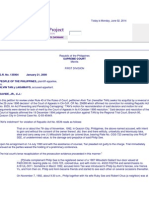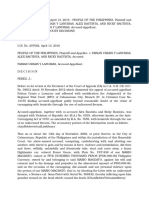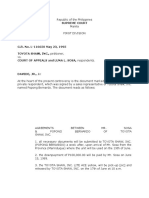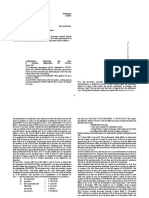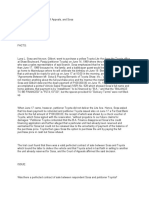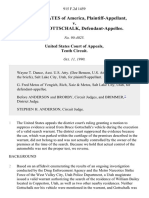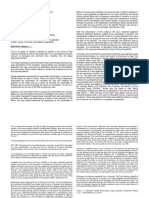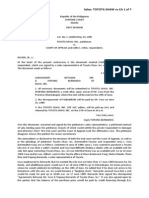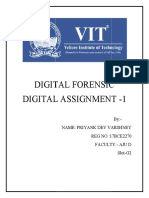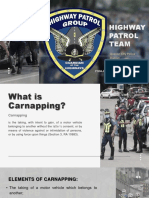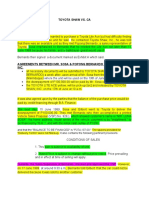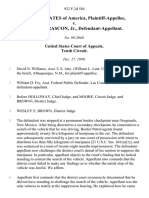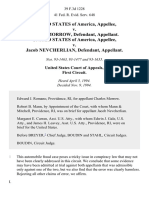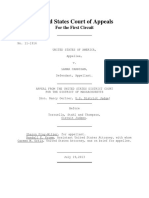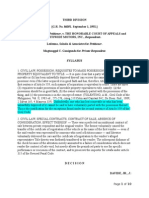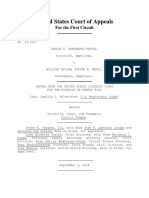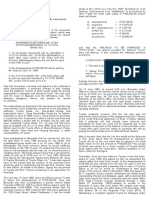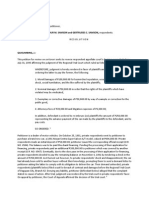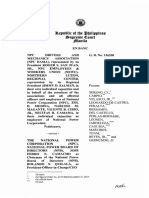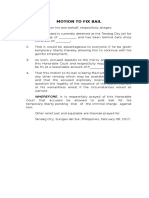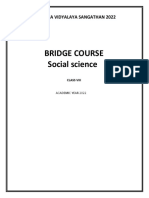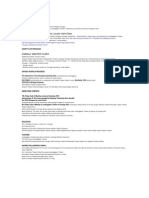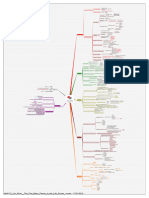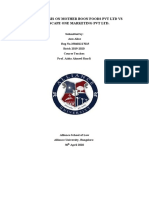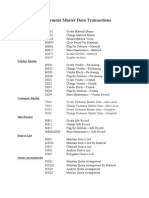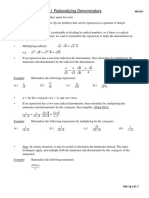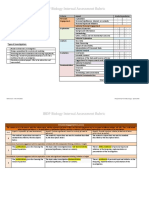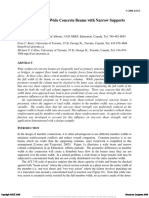FIRST DIVISION
[G.R. No. 135904. January 21, 2000]
PEOPLE OF THE PHILIPPINES, plaintiff-appellee vs. ALVIN TAN y
LAGAMAYO, accused-appellants.
DECISION
DAVIDE, JR., C.J.:
In this petition for review under Rule 45 of the Rules of Court, petitioner Alvin Tan (hereafter
TAN) seeks his acquittal by a reversal of the 29 June 1998 decision[1] of the Court of Appeals in
CA-G.R. CR No. 20688 which affirmed his conviction for violating Republic Act No. 6539, An
Act Preventing and Penalizing Carnapping.[2] TAN's motion for reconsideration of said decision
and motion for oral arguments were denied for lack of merit by the Court of Appeals in its 6
October 1998 resolution.[3] Said decision and resolution of the Court of Appeals affirmed the 19
December 1994 judgment of conviction against TAN by the Regional Trial Court, Branch 95,
Quezon City in Criminal Case No. Q-93-45449.
TANs indictment[4] for violation of Republic Act No. 6539 reads as follows:
That on or about the 7th day of November, 1992, in Quezon City, Philippines, the
above-named accused, with intent to gain and without the consent of the owner
thereof, did, then and there willfully, unlawfully and feloniously take, steal and
carry away one (1) Mitsubishi Gallant car colored blue, bearing Plate No. CGS-
723 owned by one PHILIP SEE, of undetermined value, to the damage and
prejudice of said Philip See.
Upon his arraignment on 14 July 1993 and with the assistance of counsel, Tan pleaded not guilty
to the charge. Trial immediately ensued as the parties waived the holding of a preliminary
conference.
The trial court's terse recapitulation of the prosecution evidence proceeded in this manner:[5]
xxx [P]rivate complainant Philip See is the registered owner of a 1987 Mitsubishi
Gallant four-door valued at P420,000.00, bearing plate no. CGS-723, colored
blue, and with motor no. 4G32-FG2704 and serial/chassis no. A161UL-3011.
Sometime in March 1992, accused Alvin Tan was introduced to Philip by Alvin's
fiancee, one Vienna Yu, and from then on, Philip and Alvin became friends and
started to see each other on several occasions thereafter.
On November 7, 1992, about 9:30 a.m., Philip together with his wife Ruby See
and Robert Chua (a neighbor) was at his place of residence xxx when Alvin
�arrived thereat. He made it known to Philip that he was intending to buy Philip's
aforesaid car and that he wanted to test-drive it. On account of their friendship
and believing Alvin's assurance that he would return the car after he shall have
test-driven it, Philip granted Alvin's request xxx. On thus getting hold of the car,
Alvin sped away and never returned. In vain, Philip waited for Alvin to show up
and return the car; Alvin simply did not show up, much less cause the return of
the car. Jksm
Thus, Philip started to call up and look for Alvin at his office at Roosevelt
Avenue, QC, but Alvin avoided him by refusing to answer the telephone calls or
pretending he was not around; and Philip's attempts to see Alvin at his office
similarly proved futile, for whenever Philip would go to said office, Alvin would
refuse to see him. Dismayed though he was, Philip desisted as long as he could
from reporting and complaining about the matter to the authorities; Philip still
believed that being a friend, Alvin eventually would come around to returning the
car to him. Meanwhile, sometime on March 5, 1993, with the assistance of some
personnel of the Land Transportation Office (LTO), Philip was able to cause the
car's 1993 renewal registration in the absence of the vehicle and he was issued the
corresponding official receipt therefor.
Sometime on May 19, 1993, Philip again tried to see Alvin at his place at
Roosevelt. Again Philip was told that Alvin was not around. One of Alvin's
employees, however, advised Philip to the effect that the car was parked and
hidden right behind Alvin's warehouse. The location of the warehouse having
been given to him, Philip went to the place and at a distance of some five feet, he
saw the vehicle parked at the rear end of the warehouse. To his shock and
surprise, he saw that parts of the car, like the bumper, a door, and several interior
accessories, had been dismantled and were already missing. Worse, several pieces
of wood were piled on top of the car as if purposely hide and conceal it from
view.
Still failing to recover his car, Philip on or about June 2, 1993, formally lodged a
complaint for carnapping against Alvin before the QC police station. Some two
days later, or on June 4, 1993, Philip reported the loss of his car to the Philippine
National Police (PNP) Traffic Management Command and he accordingly signed
the corresponding complaint sheets. Too, an alarm for the subject car was issued.
To his further shock and consternation, Philip was informed by the PNP's
Highway Patrol Group (HPG) that somebody had applied for a clearance to sell
the car and that the applicant was made to appear as one Philip See. xxx Philip
denied his alleged signature on the application and also denied having supposedly
applied for clearance to sell his vehicle.
Meanwhile, acting on the complaint lodged by Philip against Alvin before the QC
police station 1, the police authorities scheduled a visit to the place of Alvin, with
Philip being asked by them to pinpoint and identify Alvin in the course thereof.
Accordingly, at Alvin's place, he was identified and invited by the police to the
� station for investigation. While still at Alvin's office, Philip saw on top of Alvin's
table what Philip believed to be accessories from his car, consisting of a two-way
radio antenna and car stereo, which appeared to him to have been dismantled from
the subject car.
At that time Alvin took the car supposedly to test-drive it on November 7, 1992,
the car was in top condition, had low mileage, was 'fully loaded' with complete
interior accessories including an imported Kenwood stereo, and had imported
magwheels. Chief
Expectedly, Tan impugned the prosecution's version and presented a completely diverse tale.
Firstly, TAN asserted that Philip See (hereafter SEE) filed the complaint to purposely collect a
debt from him and wittingly use the court as collecting agent. Secondly, TAN claimed that SEE
instituted the complaint in revenge of the quarrels they had over TANs girlfriend whom SEE
wooed, and (2) in retaliation against the complaint for grave threats and illegal possession of
firearms filed by one of TAN's employees against SEE.
TAN then traced this legal predicament to the time when his girlfriend introduced him to SEE in
March 1992. TAN and SEE instantly became friends for they shared a similar acumen for
business and passion for target shooting. Inevitably, they engaged in and entered into several
business transactions which resulted in TAN's indebtedness to SEE in the amount of P800,000.
Inspite of this, SEE still offered to sell the subject Mitsubishi Galant to TAN for the amount
of P280,000. TAN declined the offer. SEE persisted to the extent that he brought the car to
TAN's residence on 26 November 1992 and generously suggested that he would just add into the
latter's existing indebtedness to him the car's purchase price.
Sometime in February 1993, SEE tried to collect the car's purchase price but TAN had still no
funds. So TAN suggested that he would apply with a bank for a car loan using the car as security
and apply the proceeds of said loan in payment for the car. SEE agreed. Subsequently, TAN
submitted in his name a loan application with the BPI Family Bank in Makati. In compliance
with the requirements of the loan application, SEE personally supervised the car's appraisal and
inspection on 19 March 1993. TAN additionally maintained that he and SEE signed a deed of
sale covering the subject automobile but that TAN did not receive a copy of said deed upon
SEE's pretext that he would use it for facilitation of the loan.
The bank approved the loan application but only in the amount of P129,000. Naturally, SEE
considered the amount insufficient and hence, refused to accept the terms of the loan.
Consequently, TAN did not seek the release of the loan. Esm
The friendship eventually soured and the resulting "misunderstanding" with SEE impelled TAN
on 19 May 1993 to instruct his warehouse overseer to return the car to SEE's residence. TAN's
employee drove the car to SEE's house, parked the car outside the gate and then handed over the
keys of the car to SEE's wife, Ruby.
�Tan was therefore surprised when on 14 June 1993, police officers arrived at his residence and
invited him to the police station; this, to TAN's additional bewilderment, was in connection with
SEE's complaint for the carnapping of the car he already returned. TAN peacefully went with the
police authorities to the station.[6]
Weighing the evidence thus proffered, the trial court believed in the prosecutions version,
particularly in SEE's clear, positive, and straightforward account - which said court found amply
demonstrated - that SEE had withdrawn the consent initially given to TAN when the latter went
beyond test-driving and appropriated the car for his own use and benefit. To the trial court,
TAN's failure to return the car and his consequent appropriation thereof constituted unlawful
taking -- the gravamen of the crime charged. It then concluded that TAN was obviously actuated
by intent to gain. The trial court then considered as completely undeserving of belief, TAN's
supposition that despite his heavy indebtedness and given his increasing difficulty to pay his
loans, SEE had benignly extended him credit, delivered to him the subject car and bestowed
upon him the ultimate privilege of paying the car at his convenience. Thus, in a decision
promulgated on 19 January 1994, the trial court convicted TAN, the dispositive portion of which
read as follows:[7]
WHEREFORE, the Court finds accused Alvin Tan y Lagamayo guilty beyond
reasonable doubt of the crime of carnapping charged herein, defined and punished
in Sec. 2, in connection with Sec. 14, both of Rep. Act No. 6539 xxx and,
accordingly, he is hereby sentenced to suffer the indeterminate penalty of
imprisonment of from fourteen years, eight months, and fifteen days as minimum,
to seventeen years and four months as maximum; to restore to the offended party,
Philip See, the subject car x x x or in default thereof, to indemnify said offended
party in the sum of four hundred twenty thousand pesos; and, to pay the costs,
without prejudice to the application of Rep. Act No. 6127 in accused's favor. Esmsc
TAN filed a motion for new trial on the ground of newly discovered evidence which was granted
by the trial court in its 4 July 1994 order. SEE then moved for reconsideration, but was denied by
the trial court in its 1 March 1995 order. SEE challenged these aforementioned orders of the trial
court in a petition for certiorari filed with the Court of Appeals. On 23 August 1995, the
appellate court gave due course to and granted the petition. TAN assailed the decision of the
Court of Appeals through a petition for review before the Supreme Court, which promptly
dismissed the petition.[8]
Subsequently, based on TAN's "Notice of Appeal Ex Abundanti Ad Cautelam," the trial court
ordered the elevation of the records of the case to the Court of Appeals.
Meanwhile, TAN challeged the Court of Appeals' affirmance of his conviction. He argues before
this Court that the appellate court erred in (1) ignoring the peculiar nature of the law on
carnapping, (2) disregarding that there was no unlawful taking, and (3) rejecting circumstances
on record which, if considered, would be sufficient to acquit him on reasonable doubt.
In invoking the specificity of the carnapping law, TAN contends that the Court of Appeals
should not have employed as bases for his conviction the basic principles in theft enunciated in
�(1) People v. Roxas,[9] where rice was received, carted away and consumed, (2) U.S. v. de
Vera,[10] where a bar of gold and P200 in bank notes were received for examination and changing
into coins but instead appropriated, and (3) People v. Trinidad,[11] where a ring was received for
pledging but was sold and the proceeds thereof appropriated for the personal use of receiver.
A cursory reading of the pertinent portion of the challenged Court of Appeals decision reveals
that the basic principles of theft alluded to pertain to the signification of unlawful taking and as
to when this takes place. Thus, the Court in Roxas, de Vera and Trinidad declared that "the
unlawful taking or deprivation may occur at or soon after the transfer of physical possession"
where "an act done by the receiver soon after the actual transfer of possession resulted in
unlawful taking." In such a case, "the article was taken away, not received, although at the
beginning the article was in fact given and received." Hence, in applying these principles, the
Court of Appeals adopted the theory of the Solicitor General that SEE entrusted his car to TAN
merely for test driving, and the latter initially received the same for that purpose only; TAN must
perforce be deemed to have unlawfully "taken" the car soon after the test-driving for he failed to
show-up and return said vehicle.[12]
There is no arguing that the anti-carnapping law is a special law, different from the crimes of
robbery and theft included in the Revised Penal Code. It particularly addresses the taking, with
intent of gain, of a motor vehicle belonging to another without the latters consent, or by means of
violence against or intimidation of persons, or by using force upon things.[13] But a careful
comparison of this special law with the crimes of robbery and theft readily reveals their common
features and characteristics, to wit: unlawful taking, intent to gain, and that personal property
belonging to another is taken without the latters consent. However, the anti-carnapping law
particularly deals with the theft and robbery of motor vehicles.[14] Hence, a motor vehicle is said
to have been carnapped when it has been taken, with intent to gain, without the owners consent,
whether the taking was done with or without violence or intimidation of persons or with or
without the use of force upon things. Without the anti-carnapping law, such unlawful taking of a
motor vehicle would fall within the purview of either theft or robbery which was certainly the
case before the enactment of said statute. Esmmis
Obviously, TANs proposition that the rudiments of theft, particularly as regards unlawful taking,
should not have been applied by the Court of Appeals, was misplaced. We shall see later on that
the appellate courts interpretation redounded in TANs favor. As an element common to theft,
robbery and carnapping, unlawful taking -- its import, intention and concept -- should be
considered as also common to these crimes.[15] However, we reject the Court of Appeals
acceptance, hook, line and sinker of the Office of the Solicitor Generals thesis that there was
unlawful taking in this case.
SEE asserted that on 7 November 1992 he turned over possession of his Mitsubishi Galant to
TAN for test-driving only, but the latter did not return the same after the lapse of not just several
hours but a number of months. SEE formally filed the complaint for carnapping on 2 June 1993.
In the meantime, during the seven-month interval when the car was allegedly in TANs
possession, (1) SEE had persistently and perseveringly attempted to talk to and see TAN but the
latter adamantly refused to respond to his telephone calls or personally receive him in his visits;
(2) SEE was able to register the car with the LTO on 5 March 1993; and (3) SEE had seen his car
�on 19 May 1993 from a distance of some five feet, parked at the rear of TANs warehouse and in
the initial stages of dismantling. SEE also believed that "being a friend, [TAN] eventually would
come around to returning the car to him."[16] Esmso
Even solely from this testimony, this Court finds that there was no unlawful taking. A felonious
taking may be defined as the act of depriving another of the possession and dominion of movable
property without his privity and consent and without animus revertendi.[17] Thus, an unlawful
taking takes place when the owner or juridical possessor does not give his consent to the taking;
or, if the consent was given, it was vitiated; or in the case of Roxas, Trinidad and de Vera, where
an act by the receiver soon after the actual transfer of possession constitutes unlawful taking. In
the last scenario, the receivers act could be considered as having been executed without the
consent of the giver. SEEs testimony clearly evinced his assent to TANs taking of the car not
only at the time he yielded the physical possession thereof for the alleged test-driving but even
thereafter, for he neither withheld his consent nor withdrew the same during the seven month
period the car was with TAN. At the very least, SEE tolerated TAN's possession of the car. A
contrary conclusion inspires only disbelief. For if the car was truly carnapped, why did SEE wait
for seven months before he reported the same? Further, TANs alleged refusal to meet SEE
despite his repeated attempts to do so should have sufficiently alerted him of the formers
supposed malevolent intent, yet he still did not report the taking. Even if he failed to report the
taking, months after the alleged test-driving, he had allegedly seen his car in the initial stages of
dismemberment on 19 May 1993 yet, again, he did not report the carnapping on that day nor on
the next, but much later on 7 June 1993 or almost a month thereafter.
SEE said he believed and expected that the car would inevitably be returned to him. This is not
only unsatisfactory but irreconcilable and contradictory with his imputations of carnapping. For
if he believed that the vehicle would be returned to him for friendship's sake then he could not
have at the same time also believed that this friend carnapped his car. Clearly, SEEs behavior
immediately preceding, contemporaneous and subsequent to the alleged unlawful taking was
definitely not the distraught conduct of a man whose car was carnapped. He was even able to
register the averred stolen vehicle without sounding the alarm.
A fortiori, the cases of Roxas, Trinidad and de Vera cited by the Court of Appeals have no
application here as no unlawful deprivation or taking of SEEs possession of, enjoyment and
benefit over the car occurred soon or long after his initial consent to the transfer thereof. Neither
was there an act executed by TAN soon after the alleged test-driving that would constitute
unlawful taking. These conclusions are buttressed by TANs testimony, duly supported by
documentary evidence, that SEE cooperated with him for the availment of a car loan with the
BPI Family Bank in Makati, and that SEE personally attended to the inspection and appraisal of
the subject car. The records, therefore, do not support the finding of carnapping. Msesm
Noticeably, the Court of Appeals' erroneous contrary conclusions were heavily predicated on the
arguments of the Office of the Solicitor General that TANs failure to show a written deed of sale
and to seek the release of his car loan "were inconsistent with [the latter's] idea of sale." It then
posed four questions which it concluded "certainly debilitated the pretensions of [TAN]," thus:[18]
If there was really a deed of sale, why could not [TAN] present a copy thereof?
� Assuming arguendo that [SEE] got [TANs] copy of the deed of sale, why did he
not secure another copy from the notary public who notarized the same? Or, better
still, why did he not present the notary public to testify on the fact of the sale?
Why did [SEE] have to sell the subject car to [TAN] at P280,000.00 when the
latter was admittedly indebted to the former to the tune of P800,000?
If [TAN] really bought the subject car from private complainant, why did he have
to return the same (car) to the latter on May 14, 1993?
From this line of reasoning, we easily deduce that the Court of Appeals simply equated the lack
of a written deed of sale to SEE's lack of consent to TAN's taking of the car. But the mere
absence of a written contract of sale in this case does not necessarily mean that SEE did not also
consent to the taking nor that TAN's possession of the car was unlawful. The prosecution still has
the onus probandi of showing that TAN's taking was unlawful. What took place in these
proceedings was that the appellate court magnified the weakness of the defense and overlooked
the prosecutions failure to discharge the onus probandi -- to show beyond reasonable doubt that
the crime of carnapping was indeed perpetrated. In short, the Court of Appeals and the trial court
simply believed and accepted the prosecutions tale. It ignored the basic legal precepts that
conviction rests upon the strength of evidence of the prosecution and not on the weakness of the
evidence for the defense; and assuming that the evidence of the accused is weak, the same is no
reason to convict, especially, as in this case, where the case of the prosecution is not strong
enough to sustain a conviction.[19] To reiterate, the burden of proof rests upon the prosecution, and
unless the State succeeds in proving by overwhelming evidence the guilt of the accused, the
constitutional presumption of innocence applies. A conviction in criminal cases must rest on
nothing less than the moral certainty of guilt.[20] Exsm
There is no quarrel in the conclusiveness of the findings of fact of the Court of Appeals, for upon
this principle hinges the rule that the jurisdiction of the Supreme Court in cases brought before it
from the Court of Appeals is limited to reviewing errors of law. However, it appears on record
that the appellate court overlooked, ignored, and disregarded some fact and circumstance of
weight or significance that if considered would have altered the result. Cogent reasons therefore
exist justifying the disregard of the findings of the appellate court, superseding the same with our
own determinations and conclusions, and ordering the reversal of the questioned decision and
resolution of said Court of Appeals.[21]
WHEREFORE, in view of all the foregoing, the herein impugned 29 June 1998 decision and 6
October 1998 resolution of the Court of Appeals affirming the trial courts judgment convicting
accused-appellant Alvin Tan of violation of the Anti-Carnapping Act of 1972 are hereby
REVERSED and SET ASIDE; a new judgment is entered ACQUITTING said accused-appellant
on ground of reasonable doubt.
Costs de officio.
SO ORDERED.
�Puno, Kapunan, Pardo, and Ynares-Santiago, JJ., concur.2/7/00 1:13 PM
[1]
Per Mabutas, Jr., R., J., with Cui, C., and Aquino, H., JJ., concurring. Rollo, 38-51.
[2]
Otherwise known as the Anti-Carnapping Act of 1972.
[3]
Rollo, 52.
[4]
Original Record (OR), Vol.1, 1-2; Rollo, 39.
[5]
Id., 39-41.
[6]
See Rollo, 41-43 for a summary the defense evidence for the defense.
[7]
Id., 38.
[8]
Docketed as G.R. No. 122784.
[9]
C.A. No. 14953-R, 53 O.G. 716 (1956)
[10]
43 Phil 1000 (1922)
[11]
50 Phil 65 (1927)
[12]
See Rollo, 45-46.
[13]
Section 2, R.A. 6539; People v. de la Cruz, 183 SCRA 763, 779 (1990); Chua v. Court of Appeals, 222 SCRA 85,
89 (1993)
[14]
In Izon v. People, 118 SCRA 119, 123 (1981), a motor vehicle within the meaning of the Anti-Carnapping Act
refers to any vehicle which is motorized and using the streets which are public.
In affirming the conviction of the accused for carnapping in People v. Alhambra, 233 SCRA 604, 614 (1994), the
[15]
Court applied the principle of larceny, thus:
When it is proven that the property stolen is found in the possession of a person, who is unable to give a satisfactory
explanation as to his possession of such property, a prima facie case is made against such person sufficient to justify
his conviction of the crime of larceny of said property. Men who come honestly into the possession of the property
have no difficulty in explaining the method by which they came into such possession.
[16]
Rollo, 40.
[17]
See 3 RAMON C. AQUINO and CAROLINA GRIO-AQUINO, THE REVISED PENAL CODE 98, 4th ed.
[18]
Rollo, 48.
[19]
People v. Ortiz, 266 SCRA 641, 654-655 (1997); People v. Alvario, 275 SCRA 529, 535 (1997)
[20]
People v. Dural, 223 SCRA 201, 214 (1993); People v. Pidia, 249 SCRA 687, 702-703 (1995); See also
People v. Casinillo, 213 SCRA 777, 787-788 (1992)
[21]
People v. Pidia, supra note 21 at 696; Cruz v. Court of Appeals, 216 SCRA 350, 359 (1992); Vda. de
Alcantara v. Court of Appeals, 252 SCRA 457, 468 (1996)


